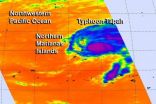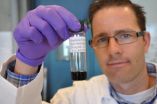(Press-News.org) April 29, 2014 – Developing immunotherapies for cancer is challenging because of significant variability among tumors and diversity in human immune types. In a study published online today in Genome Research, researchers examined the largest collection of tumor samples to date to predict patient-specific tumor mutations that may activate the patient's immune system, paving the way for more successful, personalized cancer immunotherapy.
Tumor cells accrue mutations in their DNA, and as these mutations accumulate, the cell looks less and less like part of the body and more like a foreign invader to the immune system. Cancer patients with stronger anti-tumor immune responses, mediated by T cells, are more likely to live longer. Much research has focused on strategies to harness the immune system to fight cancer; however, it has been difficult to determine the tumor mutations that activate a patient's T cells because the mutations occur sporadically, and successful activation depends on the patient's immune type (specifically, their HLA type), which varies considerably from person to person.
In this new study, the authors used a collection of over 500 tumor samples to computationally predict, using both the mutation profile and the individual's immune type, which tumor mutations are likely to be "immunogenic," causing an immune response in the patient. They found that patients with one or more immunogenic mutations had higher expression of a known T cell marker, indicative of an anti-tumor T cell response. Furthermore, these patients had higher overall survival rates than patients without immunogenic mutations, suggesting the mutations are eliciting a protective immune response.
This study highlights the "personalized nature of the tumor-immune interaction" said the lead author of the study, Robert Holt. "Cancer immunotherapy is most likely to be successful if it is personalized, that is, targeted to each individual patient's immune type and mutation profile." With the decreasing cost of DNA sequencing, "it is now feasible to map these mutational profiles and design individual vaccines in relatively short order," Holt said.
Furthermore, the study demonstrates that tumors harboring large numbers of mutations are more likely to benefit from cancer immunotherapy, because they are more likely to have mutations that make the tumor susceptible to the immune system.
Holt added, "these results also support an entirely new approach to immunotherapy: creating personalized cancer vaccines that use tumor-specific immunogenic mutations to enhance anti-tumor immunity." The team is now looking to apply this strategy in combination with conventional cancer therapies.
The data in this study was generated by The Cancer Genome Atlas (TCGA), a comprehensive resource of genomic information from a large number of patient samples, funded by the U.S. National Institutes of Health.
INFORMATION:
Scientists from BC Cancer Agency, University of British Columbia, University of Victoria, and Simon Fraser University contributed to this study.
This work was supported by funding from the BC Cancer Foundation, Canadian Institutes of Health Research, and the U.S. Department of Defense.
Media contacts:
The authors are available for more information by contacting:
Jenn Currie, Communications Officer, BC Cancer Agency (jenn.currie@bccancer.bc.ca, +1-604-675-8106)
Interested reporters may obtain copies of the manuscript via email from Peggy Calicchia, Administrative Assistant, Genome Research (calicchi@cshl.edu, +1-516-422-4012).
About the article:
The manuscript will be published online ahead of print on 29 April 2014. Its full citation is as follows:
Brown SD, Warren RL, Gibb EA, Martin SD, Spinelli JJ, Nelson BH, Holt RA. 2014. Neo-antigens predicted by tumor genome meta-analysis correlate with increased patient survival. Genome Res doi: 10.1101/gr.165985.113
About Genome Research:
Launched in 1995, Genome Research is an international, continuously published, peer-reviewed journal that focuses on research that provides novel insights into the genome biology of all organisms, including advances in genomic medicine. Among the topics considered by the journal are genome structure and function, comparative genomics, molecular evolution, genome-scale quantitative and population genetics, proteomics, epigenomics, and systems biology. The journal also features exciting gene discoveries and reports of cutting-edge computational biology and high-throughput methodologies.
About Cold Spring Harbor Laboratory Press:
Cold Spring Harbor Laboratory is a private, nonprofit institution in New York that conducts research in cancer and other life sciences and has a variety of educational programs. Its Press, originating in 1933, is the largest of the Laboratory's five education divisions and is a publisher of books, journals, and electronic media for scientists, students, and the general public.
Genome Research issues press releases to highlight significant research studies that are published in the journal.
Immunogenic mutations in tumor genomes correlate with increased patient survival
2014-04-29
ELSE PRESS RELEASES FROM THIS DATE:
Vitamin D may raise survival rates among cancer patients
2014-04-29
Washington, DC—Cancer patients who have higher levels of vitamin D when they are diagnosed tend to have better survival rates and remain in remission longer than patients who are vitamin D-deficient, according to a new study published in the Endocrine Society's Journal of Clinical Endocrinology & Metabolism (JCEM).
The body naturally produces vitamin D after exposure to sunlight and absorbs it from certain foods. In addition to helping the body absorb the calcium and phosphorus needed for healthy bones, vitamin D affects a variety of biological processes by binding to ...
Study: WHO tool underestimates need for osteoporosis treatment
2014-04-29
Washington, DC—The World Health Organization's tool for assessing bone fracture risk underestimates the true dangers for people who are younger than 65 or have been treated for a single broken bone, according to a new study published in the Endocrine Society's Journal of Clinical Endocrinology & Metabolism (JCEM).
A WHO task force developed the Fracture Risk Assessment Tool (FRAX) to help predict the likelihood of adults between the ages of 40 and 90 breaking a bone. FRAX is designed to evaluate the chances that a person will break a bone in a minor fall, which is called ...
Declines in large wildlife lead to increases in disease risk
2014-04-29
In the Middle Ages, fleas carried by rats were responsible for spreading the Black Plague. Today in East Africa, they remain important vectors of plague and many other diseases, including Bartonellosis, a potentially dangerous human pathogen.
Research by Hillary Young, assistant professor in UC Santa Barbara's Department of Ecology, Evolution and Marine Biology, directly links large wildlife decline to an increased risk of human disease via changes in rodent populations. The findings appear today in the Proceedings of the National Academy of Sciences Early Online Edition.
With ...
Chronic stress heightens vulnerability to diet-related metabolic risk
2014-04-29
New research out of UC San Francisco is the first to demonstrate that highly stressed people who eat a lot of high-fat, high-sugar food are more prone to health risks than low-stress people who eat the same amount of unhealthy food.
"Chronic stress can play an important role in influencing biology, and it's critical to understand the exact pathways through which it works." said Kirstin Aschbacher, PhD, an assistant professor in the UCSF Department of Psychiatry and lead author. "Many people think a calorie is a calorie, but this study suggests that two women who eat the ...
GWAS study ties ABCC9 anomalies, sulfonylurea exposure to HS-Aging
2014-04-29
LEXINGTON, Ky. (April 29, 2014) -- A genome-wide association study (GWAS) led by Peter Nelson, MD, PhD, of the Sanders-Brown Center on Aging at the University of Kentucky, and David Fardo, PhD, of UK's Department of Biostatistics, has provided new insight into Hippocampal Sclerosis of Aging (HS-A), a common disease affecting the elderly.
Researchers from 16 different institutions compared 363 persons with autopsy-proven HS-A to a control group of 2,303 other individuals in an attempt to identify genetic predisposition to HS-Aging.
Dr. Nelson and his team found that ...
Carnegie Mellon-Disney researcher invents 3-D printing technique for making cuddly stuff
2014-04-29
PITTSBURGH—Soft and cuddly aren't words used to describe the plastic or metal things typically produced by today's 3D printers. But a new type of printer developed by Carnegie Mellon University and Disney Research Pittsburgh can turn wool and wool blend yarns into fabric objects that people might actually enjoy touching.
The device looks something like a cross between a 3D printer and a sewing machine and produces 3D objects made of a form of loose felt. Scott Hudson, a professor in CMU's Human-Computer Interaction Institute who developed the felting printer with Disney ...
Beyond graphene: Controlling properties of 2-D materials
2014-04-29
The isolation of graphene at the University in 2004 led to the discovery of many other 2D crystals. While graphene has an unrivalled set of superlatives, these crystals cover a large range of properties: from the most conductive to isolating, from transparent to optically active.
The next step is to combine several of these crystals in a 3D stack. This way, one can create 'heterostructures' with novel functionalities – capable of delivering applications as yet beyond the imagination of scientists and commercial partners.
The first examples of such heterostructures already ...
Scripps Florida scientists reveal molecular secrets behind resveratrol's health benefits
2014-04-29
JUPITER, FL, April 29, 2014 – Resveratrol has been much in the news as the component of grapes and red wine associated with reducing "bad cholesterol," heart disease and some types of cancer. Also found in blueberries, cranberries, mulberries, peanuts and pistachios, resveratrol is associated with beneficial health effects in aging, inflammation and metabolism.
Scientists from the Florida campus of The Scripps Research Institute (TSRI) have now identified one of the molecular pathways that resveratrol uses to achieve its beneficial action. They found that resveratrol ...
Tapah through infrared satellite eyes: Now a typhoon
2014-04-29
Tropical Storm Tapah strengthened since April 28 and early on April 29, the storm reached typhoon strength. From its orbit in space, NASA's Aqua satellite zoomed over Tapah and the AIRS instrument captured infrared data on the storm that showed the location of its strongest thunderstorms.
The U.S. National Weather Service in Guam noted that a tropical storm warning and a typhoon watch continues for Alamagan and Pagan. For details on the advisory, visit: http://www.prh.noaa.gov/data/GUM/HLSPQ1
The Atmospheric Infrared Sounder (AIRS) instrument that flies aboard NASA's ...
Graphene not all good
2014-04-29
RIVERSIDE, Calif. — In a first-of-its-kind study of how a material some think could transform the electronics industry moves in water, researchers at the University of California, Riverside Bourns College of Engineering found graphene oxide nanoparticles are very mobile in lakes or streams and therefore likely to cause negative environmental impacts if released.
Graphene oxide nanoparticles are an oxidized form of graphene, a single layer of carbon atoms prized for its strength, conductivity and flexibility. Applications for graphene include everything from cell phones ...




